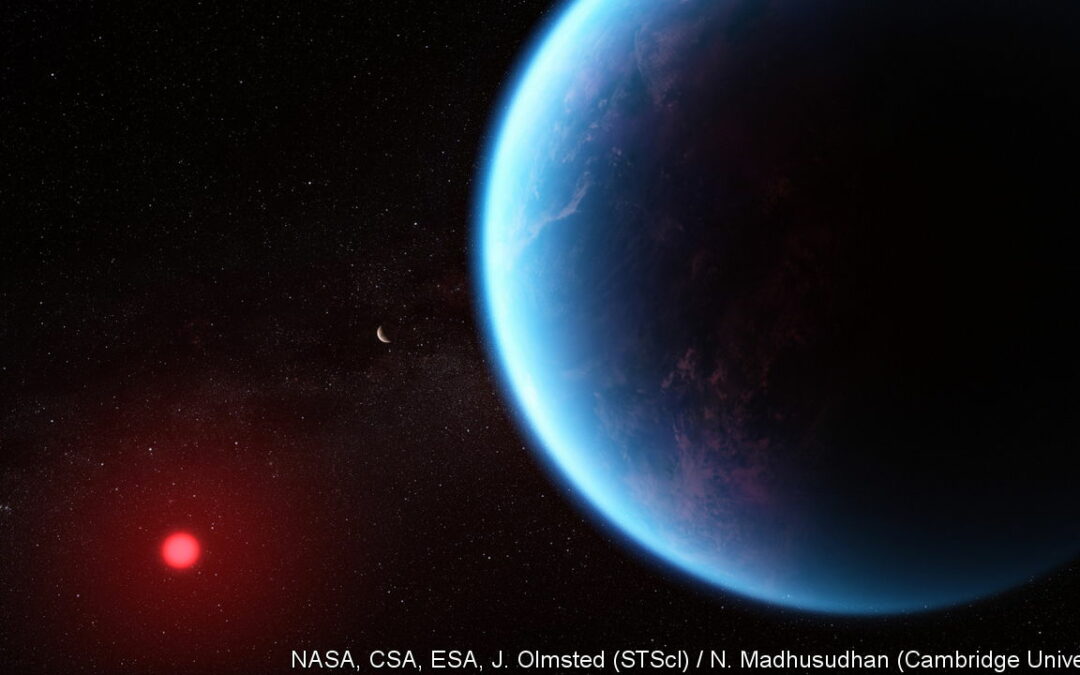A LITTLE BIT more than 124 light years from Earth, circling an otherwise uninteresting star in the constellation of Leo, sits a planet called K2-18 b. It is one of thousands of exoplanets spotted by Kepler, a space telescope that was launched in 2009 and is designed for the task. In 2019 observations by the Hubble Space Telescope suggested the planet might have water in its atmosphere; they were taken as evidence that, if it were a planet like the Earth, it might be habitable.
On September 11th there was further astronomical hubbub, if also a few worries about potential hype, when a team led by Nikku Madhusudhan of the University of Cambridge announced that observations made with the more sensitive James Webb Space Telescope (JWST) suggested K2-18 b might be what is called a “Hycean world”. What off Earth is that?
Though the term (which is pronounced with a soft c) has a classical ring to it, it was introduced into astronomy by Dr Madhusudhan just two years ago, a portmanteau of “hydrogen ocean”. It describes a kind of planet which is unknown in the solar system—but which might be both common and habitable elsewhere.
Observations of exoplanets typically provide astronomers little more than an orbit, a mass and a radius. If the radius and mass match something seen in the solar system they can guess what the object’s inner structure may be: an exoplanet the size and mass of the Earth is probably rocky. But with a radius 2.6 times that of the Earth, and a mass around nine times higher, K2-18 b is considerably bigger than any of the inner solar system’s rocky planets. But it is also much smaller than the giants which hold sway in the outer solar system: just half the mass of Neptune, less than 3% the mass of Jupiter.
With no nearby analogues to guide them, astronomers work out the structure of exoplanets from first principles: what physically self-consistent arrangement of shells of different densities can provide the right answer? The idea of a Hycean world is Dr Madhusudhan’s suggestion for an answer which would apply to planets like K2-18 b. It imagines a core of rock and iron about the size of Earth that is covered by an ocean thousands of kilometres deep, topped off with a relatively thin atmosphere composed of light gas, presumably hydrogen. Give such a planet a mass like that of K2-18 b and it will have a radius like that of K2-18 b. It will also have a planet-covering, island- and continent-free ocean in which, in principle, life could thrive.
JWST is sensitive enough to detect tiny flickers of starlight that have passed through the planet’s uppermost atmosphere—and they are consistent with such a picture. Models predict the atmosphere of such a planet should contain carbon dioxide and methane, and both were found. There was also a tentative identification of dimethyl sulphide, a molecule which on Earth is only made by life, most notably by plankton. That does not mean that it is produced by life on K2-18 b. But the almost-observation is bound to pique interest.
The sorts of processes which would produce methane in such an atmosphere should also produce ammonia, and this was not seen. But that is a Hycean feature, not a bug. Ammonia would dissolve in an underlying ocean in a way that methane would not, so only methane remains in the atmosphere.
None of this, though, proves K2-18 b to be a true Hycean world. The depth of the atmosphere in Dr Madhusudhan’s model is very important. If it is just a bit too thick, the resulting greenhouse effect would make liquid oceans impossible. Instead the lower reaches would consist of water in a very hot, high pressure, “supercritical” state that is utterly uninhabitable. Sceptics say the existence of Hycean worlds is only possible given fine tuning which provides an atmosphere thick enough not to be lost to space but thin enough not to set off a runaway greenhouse effect in its depths. The new observations offer little—other than the absence of ammonia—to rule out the possibility that K2-18 b is just such a sauna hell world.
Happily K2-18 b is not going anywhere, other than regularly round and round its parent star. There will be ample opportunities for further observations. Those should be able to show whether K2-18 b really is a habitable Hycean waterworld, and whether it really does have evocative traces of dimethyl sulphide in its atmosphere. If it does, you can expect to hear the word Hycean a lot more in years to come. ■








